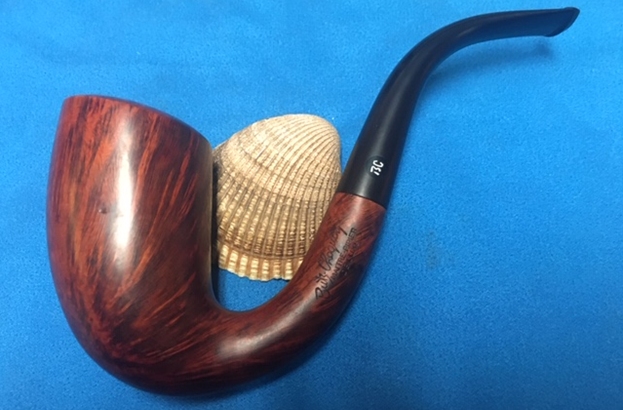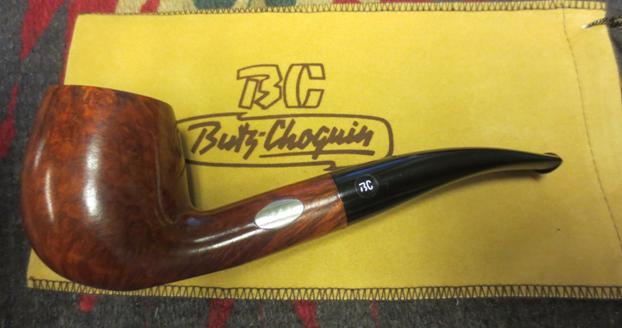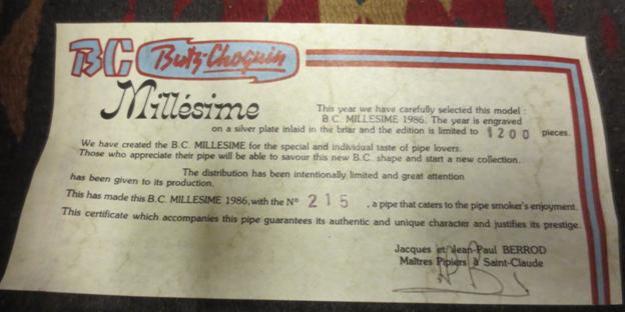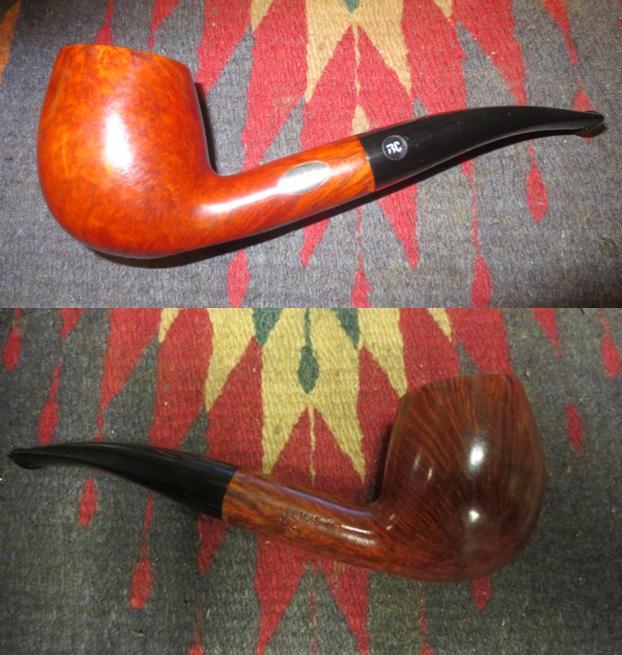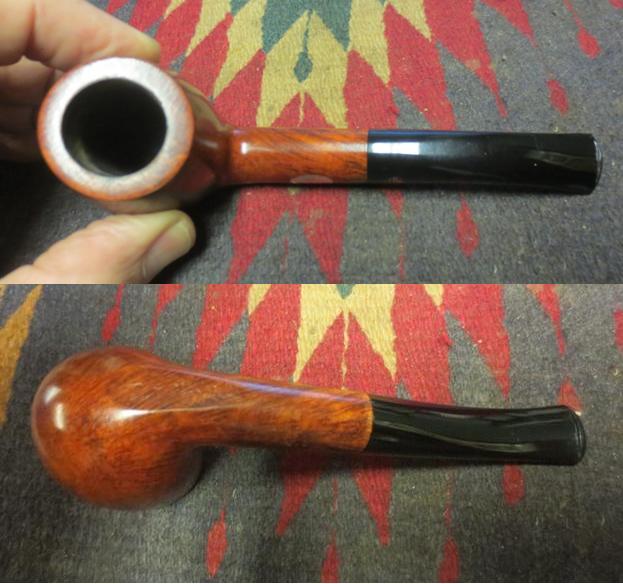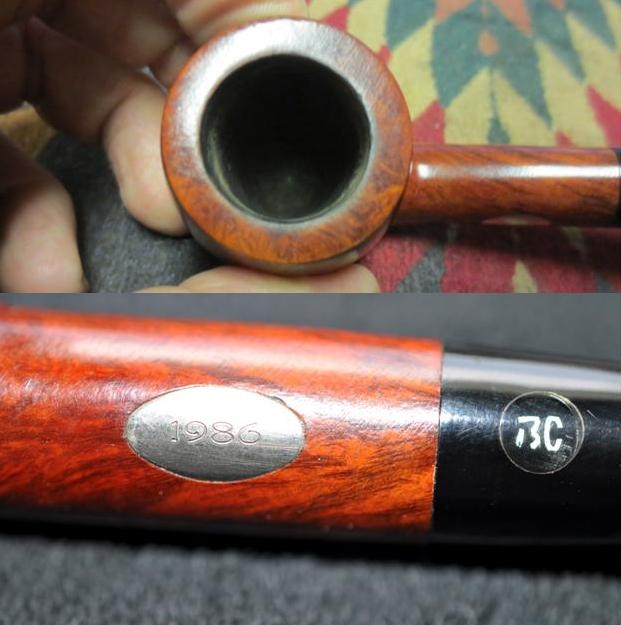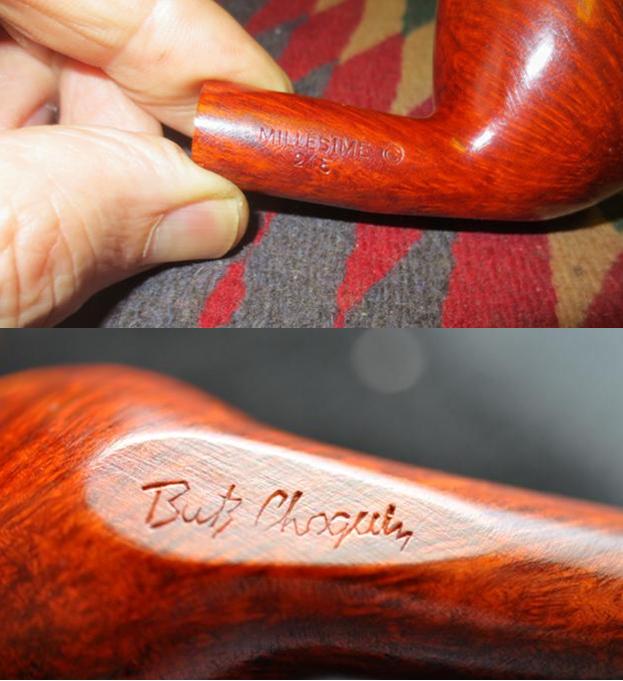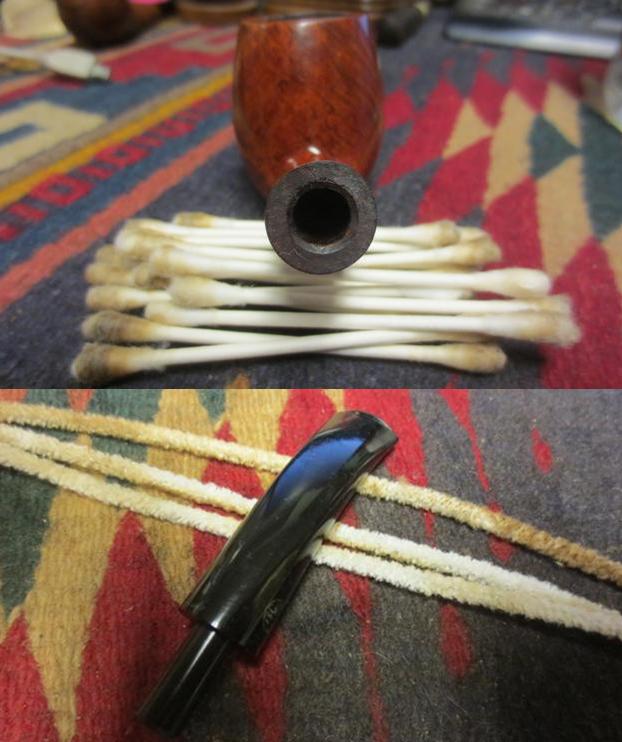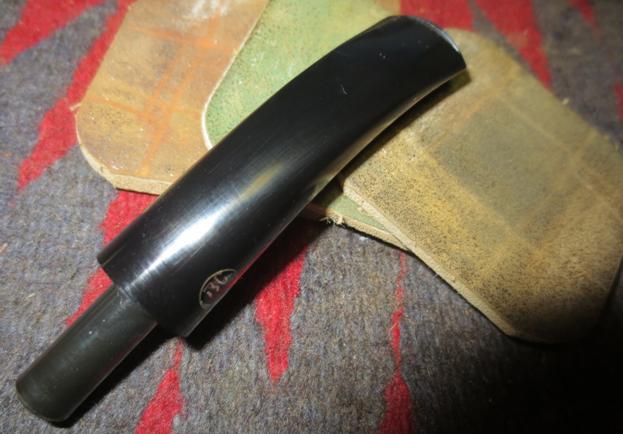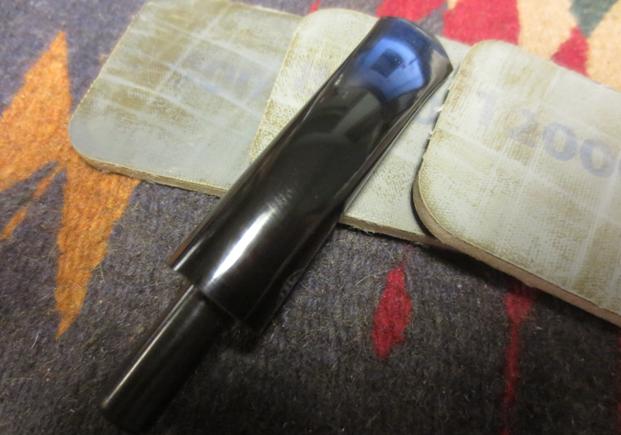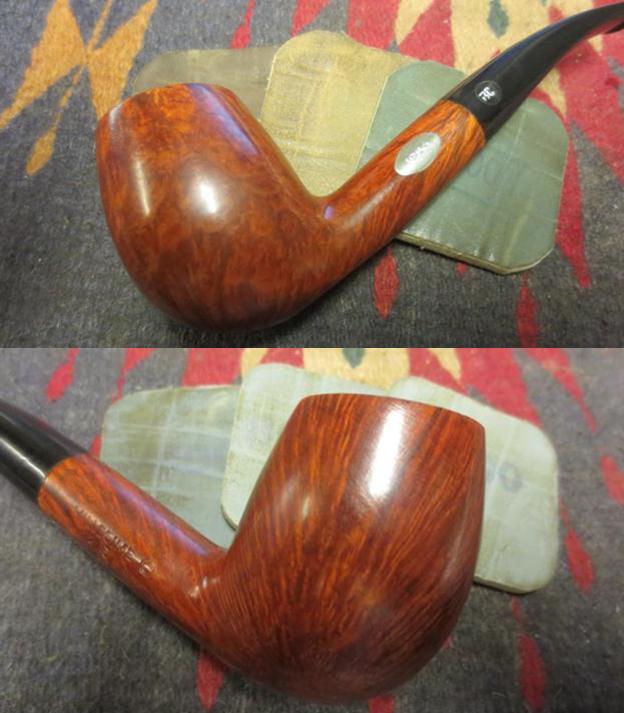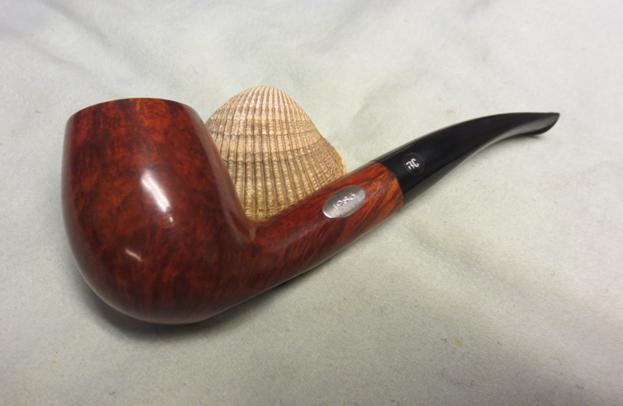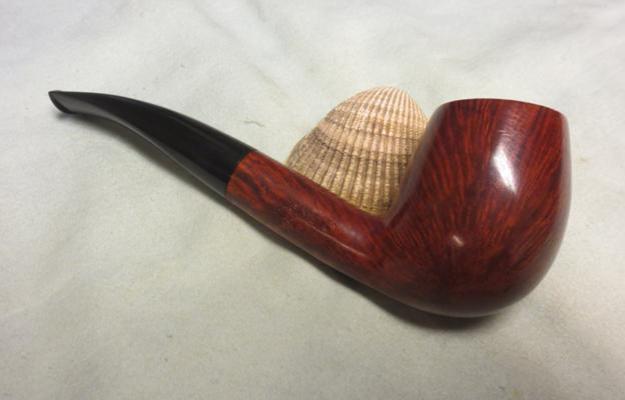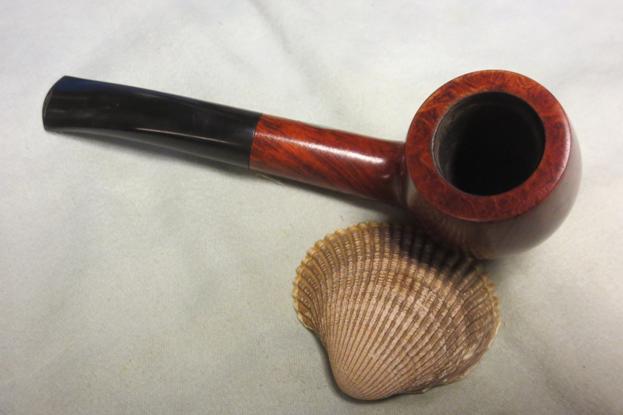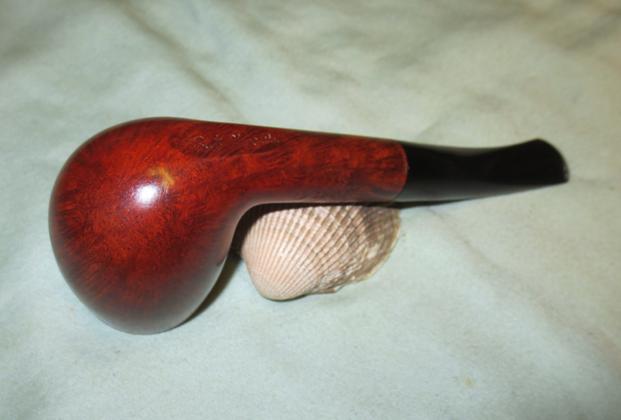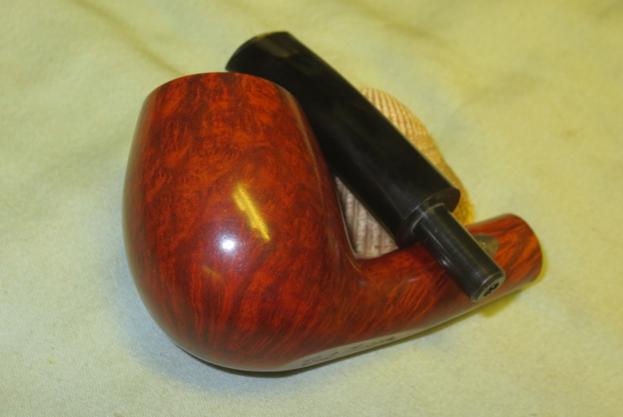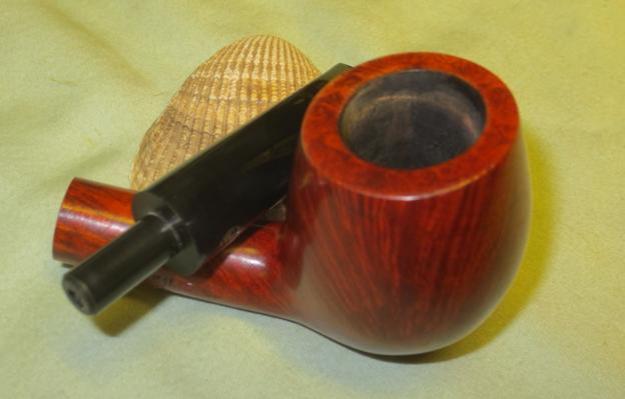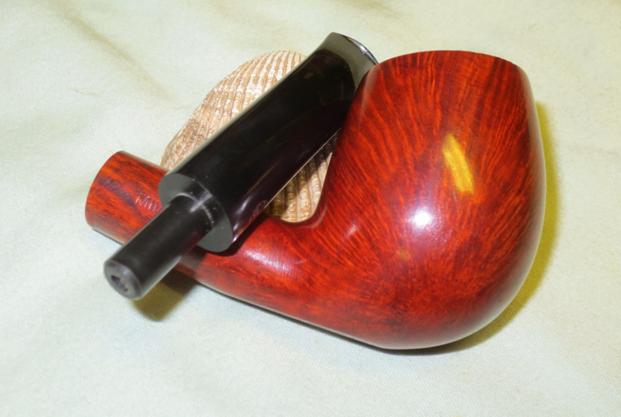Blog by Steve Laug
The next pipe on the worktable is a gracefully shaped pipe made by Butz-Choquin. It is a vulcanite tapered stem with a BC logo on the left side of the taper. The finish is smooth with some nice grain around the bowl. The bowl has straight and flame grain on the sides with mixed grain on the rim top and heel of the bowl. The curves of the shank and bowl give the bowl a sense of grace. The stem carries out the theme. The pipe is stained with black and various hues of brown. It truly is a beautiful finish. The pipe is stamped Butz-Choquin over Maitre Pipier over De Luxe on the left side of the shank. On the right side it is stamped Fait Main (Hand Made) over St. Claude France. The finish was very dirty and tired looking with a lot of grime and oils ground into the sides of the bowl. The finish is peeling and bubbling on the rim top and on the back of the bowl. It appears that the pipe had a varnish or shellac coat that is damaged. There was a thick cake in the bowl and some darkening on the inner edge of the rim top. The tapered vulcanite stem is heavily oxidized and had calcification over much carries on the twist of the shank. The stem looked good. It is dirty with light tooth marks and chatter on both sides near the button. Jeff took some photos of the pipe before he started his cleanup work. 
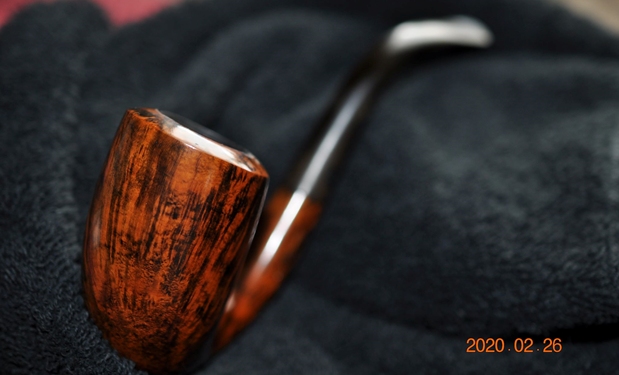 He took photos of the bowl and rim top to show their general condition. You can see the bubbling and peeling finish on the rim top. There is cake in the bowl and some darkening around the rim edges and some tars on the rim edge as well.
He took photos of the bowl and rim top to show their general condition. You can see the bubbling and peeling finish on the rim top. There is cake in the bowl and some darkening around the rim edges and some tars on the rim edge as well. 
 Jeff took some photos of the sides and heel of the bowl to give an idea of the smooth finish and the grain shining through the grime. I cannot wait to see what it looks like once it is cleaned and polished.
Jeff took some photos of the sides and heel of the bowl to give an idea of the smooth finish and the grain shining through the grime. I cannot wait to see what it looks like once it is cleaned and polished. He took several photos of the stamping on the sides of the shank to capture it for me. It is clear and readable. It reads as noted above. He also included a photo of the acrylic encased BC inlay on the left side of the stem.
He took several photos of the stamping on the sides of the shank to capture it for me. It is clear and readable. It reads as noted above. He also included a photo of the acrylic encased BC inlay on the left side of the stem. The vulcanite stem is a bit of a mess! It is oxidized and there is calcification and a rust coloured build up all over the stem from the button forward. There are also light tooth marks and chatter on both sides of the stem. The button appears to be in good condition. The photos below show the condition of the stem.
The vulcanite stem is a bit of a mess! It is oxidized and there is calcification and a rust coloured build up all over the stem from the button forward. There are also light tooth marks and chatter on both sides of the stem. The button appears to be in good condition. The photos below show the condition of the stem.  Before I started working on my part of the restoration I decided to do some research on the Maitre Pipier line to see what I could learn. I turned first to PipePhil’s site to get a quick overview of the brand (http://www.pipephil.eu/logos/en/logo-butzchoquin.html). There found the following information. I am also including a screen capture of the pertinent section from the site.
Before I started working on my part of the restoration I decided to do some research on the Maitre Pipier line to see what I could learn. I turned first to PipePhil’s site to get a quick overview of the brand (http://www.pipephil.eu/logos/en/logo-butzchoquin.html). There found the following information. I am also including a screen capture of the pertinent section from the site.
Pipes of the “Maitre Pipier” series were crafted by Paul Lanier until he retired and after him by Alain Albuisson. The model illustrated is remarkable for its “swan neck” shank.
The one pictured in the screen capture is an Extra but the shape is very similar to the one I have that is stamped De Luxe. The same swan neck shank is a part of its beauty. I turned then to Pipedia and did not find anything pertinent to this series of pipes. If you would like to learn more about the brand here is the link (https://pipedia.org/wiki/Butz-Choquin).
I turned then to Pipedia and did not find anything pertinent to this series of pipes. If you would like to learn more about the brand here is the link (https://pipedia.org/wiki/Butz-Choquin).
Now I had a pretty good idea the carvers of the Maitre Pipier Series. I am not sure of the date this pipe was made but I did know who made it. With that information I moved forward to do my part of the restoration work on the pipe itself and see what I had to do with it. The bowl looked unbelievably good in light of where it started. All of the flaking and peeling finish was gone. What remained was some very nicely grained briar. The stem looked much better with just a few tooth marks on each side of the stem just ahead of the button. Jeff had done his normal thorough clean up – reaming, scrubbing, soaking and the result was evident in the pipe when I unpacked it. I took photos of the pipe before I started my work on it. The shape and finish on this pipe is very unique.
 I took some photos of the rim top and stem. The rim top and bowl looked very good. He was able to clean up the on the top and back side as well as the cake in the bowl. The bowl, rim top and inner edges of the bowl look very good at this point. The close up photos of the stem shows that is it very clean.
I took some photos of the rim top and stem. The rim top and bowl looked very good. He was able to clean up the on the top and back side as well as the cake in the bowl. The bowl, rim top and inner edges of the bowl look very good at this point. The close up photos of the stem shows that is it very clean. I took pictures of the stamping on the shank. It is very clear and readable. Jeff’s clean up work left it unfazed and if anything more readable now that the peeling varnish coat was gone.
I took pictures of the stamping on the shank. It is very clear and readable. Jeff’s clean up work left it unfazed and if anything more readable now that the peeling varnish coat was gone. I removed the stem from the shank and took a photo of the pipe at this point. You can clearly see the condition, size and shape of the pipe. It is interesting to note the black metal tube in the end of the tenon. When the stem is in place it extends to the bend in the shank. It is removable but I will leave it in place.
I removed the stem from the shank and took a photo of the pipe at this point. You can clearly see the condition, size and shape of the pipe. It is interesting to note the black metal tube in the end of the tenon. When the stem is in place it extends to the bend in the shank. It is removable but I will leave it in place.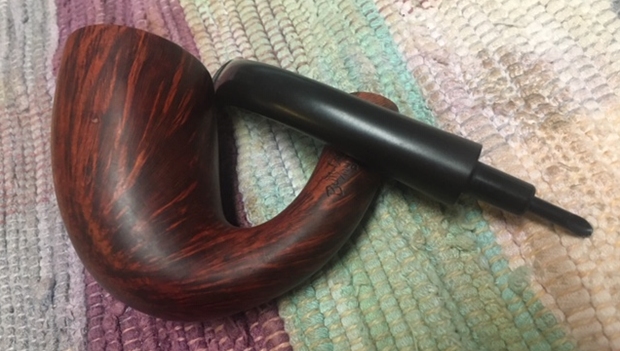 I started my restoration work on the pipe by addressing two sand pits or nicks in the finish that were like white spots on the briar. One was on the left side mid bowl and the other was on the right side lower near the shank/bowl junction. I filled them in with a spot of clear CA glue. Once the glue cured I sanded them smooth with a corner of 220 grit sandpaper and 1500 grit micromesh. I did not want to damage the finish but just smooth out the glue.
I started my restoration work on the pipe by addressing two sand pits or nicks in the finish that were like white spots on the briar. One was on the left side mid bowl and the other was on the right side lower near the shank/bowl junction. I filled them in with a spot of clear CA glue. Once the glue cured I sanded them smooth with a corner of 220 grit sandpaper and 1500 grit micromesh. I did not want to damage the finish but just smooth out the glue.
 I polished the briar with micromesh sanding pads – dry sanding with 1500-12000 grit pads. I wiped the bowl down after each pad with a damp cloth. The grain really began to stand out and the finish took on a shine by the last sanding pad. The photos tell the story!
I polished the briar with micromesh sanding pads – dry sanding with 1500-12000 grit pads. I wiped the bowl down after each pad with a damp cloth. The grain really began to stand out and the finish took on a shine by the last sanding pad. The photos tell the story!




 I worked some Before & After Restoration Balm into the surface of the briar with my fingertips. The product works to clean, enliven and protect the briar. I let the balm sit for about ten minutes and then buffed with a cotton cloth to raise the shine. The photos show the bowl at this point in the restoration process.
I worked some Before & After Restoration Balm into the surface of the briar with my fingertips. The product works to clean, enliven and protect the briar. I let the balm sit for about ten minutes and then buffed with a cotton cloth to raise the shine. The photos show the bowl at this point in the restoration process.

 I laid the bowl aside and turned to deal with the stem. I sanded the tooth marks and chatter on the stem with a folded piece of 220 grit sandpaper to blend them into the surface of the stem and started polishing with 400 grit wet dry sandpaper.
I laid the bowl aside and turned to deal with the stem. I sanded the tooth marks and chatter on the stem with a folded piece of 220 grit sandpaper to blend them into the surface of the stem and started polishing with 400 grit wet dry sandpaper.  I polished the stem with some Denicare Mouthpiece polish – a red gritty paste that feels a lot like the texture of red Tripoli. It works well to polish out some of the scratches. I find that it does a great job preparing the stem for polishing with micromesh sanding pads.
I polished the stem with some Denicare Mouthpiece polish – a red gritty paste that feels a lot like the texture of red Tripoli. It works well to polish out some of the scratches. I find that it does a great job preparing the stem for polishing with micromesh sanding pads.  I polished the stem with micromesh sanding pads – dry sanding with 1500-12000 grit sanding pads. I wiped it down after each sanding pad with a cloth containing some Obsidian Oil. I finished polishing it with Before & After Pipe Stem Polish – both Fine and Extra Fine and buffed it off with a cotton cloth. I wiped the stem down with a coat of Briarville’s No Oxy Oil to protect the rubber and slow down oxidation.
I polished the stem with micromesh sanding pads – dry sanding with 1500-12000 grit sanding pads. I wiped it down after each sanding pad with a cloth containing some Obsidian Oil. I finished polishing it with Before & After Pipe Stem Polish – both Fine and Extra Fine and buffed it off with a cotton cloth. I wiped the stem down with a coat of Briarville’s No Oxy Oil to protect the rubber and slow down oxidation.


Putting this pipe back together was very rewarding. The change in condition and appearance was remarkable. The removal of the shiny, peeling coat brought the briar back to life. I love seeing the grain just pop at this point. I put the stem back on the bowl and buffed the pipe with Blue Diamond on the buffing wheel. I carefully avoided the stamping on the shank during the process. I gave the bowl and the stem multiple coats of carnauba wax on the buffing wheel and followed that by buffing it with a clean buffing pad on the buffer. I hand buffed the pipe with a microfiber cloth to deepen the shine. The finished pipe is quite beautiful and is a graceful, swan-necked French pipe. The finish on the bowl combines various stains to give it depth. It is very well done. Give the finished pipe a look in the photos below. I can only tell you that it is much prettier in person than the photos capture. The dimensions of the pipe are Length: 6 inches, Height: 2 ½ inches, Outside diameter of the bowl: 1 ½ inches, Chamber diameter: ¾ of an inch. Butz-Choquin seems to have a lot of creatively shaped designs that leave me respecting the creativity. This interesting pipe is no exception and it is a great looking pipe in great condition. Thanks for walking through the restoration with me as I worked over another beautiful pipe. I will be adding it to the rebornpipes store soon. If you want to add it to your collection send me an email or a message! Thanks for your time.